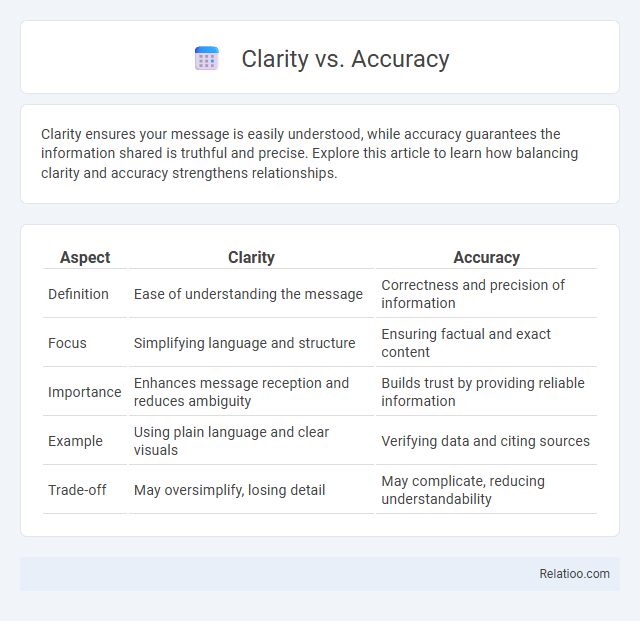Clarity ensures your message is easily understood, while accuracy guarantees the information shared is truthful and precise. Explore this article to learn how balancing clarity and accuracy strengthens relationships.
Table of Comparison
| Aspect | Clarity | Accuracy |
|---|---|---|
| Definition | Ease of understanding the message | Correctness and precision of information |
| Focus | Simplifying language and structure | Ensuring factual and exact content |
| Importance | Enhances message reception and reduces ambiguity | Builds trust by providing reliable information |
| Example | Using plain language and clear visuals | Verifying data and citing sources |
| Trade-off | May oversimplify, losing detail | May complicate, reducing understandability |
Understanding Clarity and Accuracy
Understanding clarity involves presenting information in a straightforward and easily digestible manner, minimizing ambiguity to enhance comprehension. Accuracy ensures that the information you receive or share is factually correct and reliable, forming the foundation for trust and effective decision-making. Balancing clarity and accuracy is essential for your communication to be both understandable and truthful, preventing misunderstandings and misinformation.
Defining Clarity in Communication
Defining clarity in communication involves ensuring messages are straightforward, unambiguous, and easily understood by the target audience. Clarity eliminates confusion by using precise language and structured information flow, enhancing comprehension and retention. Balancing clarity with accuracy ensures that communication is both correct and accessible, avoiding misinterpretation or misinformation.
What Does Accuracy Mean?
Accuracy means the degree to which information or data correctly represents the true value or reality without errors or distortions. It ensures your decisions are based on reliable and precise facts, minimizing mistakes caused by misinformation. In comparing clarity and accuracy, clarity involves how easily information is understood, while accuracy focuses on the truthfulness and correctness of the content.
Importance of Clarity in Information Delivery
Clarity in information delivery ensures Your message is easily understood, reducing misinterpretation and enhancing effective communication. While accuracy provides correctness and reliability, clarity shapes how information is perceived and retained by the audience. Prioritizing clarity strengthens engagement and facilitates quicker decision-making by eliminating confusion.
Significance of Accuracy in Messaging
Accuracy in messaging ensures information is truthful and precise, building trust and credibility with the audience. While clarity makes messages easy to understand and engagement seamless, accuracy prevents misinterpretation and misinformation. Prioritizing accuracy enhances decision-making and maintains the integrity of communication across all platforms.
Clarity vs Accuracy: Key Differences
Clarity focuses on making information easy to understand by using simple language and straightforward presentation, while accuracy ensures that the information is factually correct and precise. Your communication succeeds when clarity enhances comprehension without sacrificing the detailed truth accuracy provides. Balancing clarity and accuracy maximizes effective knowledge transfer and minimizes misunderstandings.
Common Misconceptions about Clarity and Accuracy
Clarity and accuracy are often mistakenly considered synonymous, but clarity focuses on how understandable the information is, while accuracy emphasizes the correctness and precision of the data. A common misconception is that overly detailed information ensures clarity, yet excessive detail can overwhelm readers and reduce comprehension. Achieving a balance where accurate information is presented clearly improves overall communication effectiveness and reduces misinterpretations.
Balancing Clarity and Accuracy in Writing
Balancing clarity and accuracy in writing involves presenting information precisely without sacrificing understandability. Clear writing uses straightforward language and structured sentences, while accurate writing ensures facts and details are correct and reliable. Achieving a balance means avoiding overly complex terminology that confuses readers while maintaining the integrity of the data and concepts conveyed.
Practical Examples: Clarity versus Accuracy
Clarity and accuracy often intersect but serve distinct purposes in communication; for example, a weather forecast saying "Heavy rain likely in the afternoon" is clear but less precise than "60% chance of 0.5-inch rainfall between 2-4 PM." Practical clarity prioritizes understandable language for the audience, while accuracy emphasizes factual correctness and detail, such as scientific reports where exact measurements matter. Balancing clarity and accuracy involves using simple terms without sacrificing essential data, like a medical summary stating "The patient's blood pressure is elevated at 150/95 mmHg" to ensure both comprehension and precision.
Strategies to Improve Clarity and Accuracy
Improving clarity and accuracy in communication involves using precise language, avoiding jargon, and organizing information logically to enhance understanding. Implementing feedback loops and fact-checking processes ensures information is both clear and reliable. Utilizing tools such as style guides and readability assessments further refines content quality, promoting effective and accurate messaging.

Infographic: Clarity vs Accuracy
 relatioo.com
relatioo.com